EcoDragons: A Game for Environmental Education and Public Outreach
Abstract
Simple Summary
Abstract
1. Introduction
2. The Protagonists—Dragonflies
3. Game Objective and Rules
4. Environment
5. Cards
5.1. Species Cards
- A body size index ranges between one and six, where one indicates a small size (e.g., Ischnura) and six indicates a large size (e.g., Anax). The body length in mm is also provided based on Dijkstra and Schröter [21].
- An environmental resilience index also ranges between one and six, where one indicates low resilience (meaning high sensitivity to environmental disturbance), and six indicates high resilience.
- Taxonomic classification shows the order, the suborder, and the family name. The common and Latin name of species is also given at the top of the card.
- Habitat preferences include lakes, ponds, marshes, rivers, and streams, indicated by the following symbols: triangle, square, circle, star, and diamond. Some species are habitat generalists and live in multiple habitat types (e.g., Pyrrhosoma nymphula which lives in various types of wetlands) whereas other species are habitat specialists and live in one or two habitats (e.g., Calopteryx splendens lives in rivers and streams).
- Conservation status is based on the European IUCN Red List and includes the following ranks: Least Concern (LC), Near Threatened (NT), Vulnerable (VU), Endangered (EN), Critically Endangered (CR), and Extinct (EX). A threatened species (NT, VU, EN, and CR) receives an extra score (conservation status score). LC, NT, VU, EN, and CR give 1, 2, 3, 4, and 5 points, respectively.
- Conservation priority index (CPI) reflects whether a species should receive special conservation attention. This index is very important in the game because it counts in the total score at the end of the game. It is calculated as: CPI = (6 − resilience index) + conservation status score. For example, Anax imperator has a resilience index of 6 and is ranked LC (conservation status score = 1), thus CPI = 6 − 6 + 1 = 1. However, Lestes macrostigma has a resilience index of 3 and is ranked VU (conservation status score = 3), thus CPI = 6 − 4 + 3 = 5. Thus, L. macrostigma has a higher conservation priority than A. imperator.
- Geographic distribution is illustrated with a map that includes Europe and part of North Africa and Western Asia. The limits of the map were fixed to 31° N–72° N latitude and 17° W–44° E longitude. Most maps were produced using shapefiles obtained from the IUCN red list website (https://www.iucnredlist.org/, accessed on 28 July 2021), R packages tmap [22], and sf [23]. When the shapefiles were not found, maps were produced manually based on Dijkstra and Schröter [21].
- Pedagogical relevance: Players are exposed to a large number of basic facts about dragonflies. Players learn that there are interspecific differences in body size, environmental sensitivities, conservation status, geographic range, and habitat preferences in a single assemblage. They also learn that some species are habitat specialists and thus are more threatened to extinction than habitat generalists. Further, some species of conservation concern have a small range size and thus need particular conservation attention. The brief taxonomic classification allows the players to learn the major taxonomic ranks and the name of families and species.
5.2. Anthropogenic Cards
5.3. Action Cards
5.3.1. Ecology Cards
- Weather: In nature, dragonflies are active in warm and sunny weather, and adverse weather conditions such as rain, wind, and frost stop their activity. To reflect this effect in the game, abiotic cards stop the player from playing for one (wind and rain) or two rounds (frost).
- Predation: Three predators with different size-dependent predation capacities are provided (frog, passerine, and hawk). The frog eats only species with size indices ≤2. The passerine bird eats species with size indices ≤4, whereas the hawk eats only large dragonflies ≥5. While this predator-prey interaction might not accurately reflect the interactions in the real world (e.g. a frog or a passerine could eat a large dragonfly), it introduces more complexity in the game and highlight the potential size-dependent structure in community interactions.
- Intraguild predation: This kind of predation is also a process by which a dragonfly species could eat a smaller or equally sized species living in the same habitat.
- Competition: This refers only to interspecific competition. If players share the same habitat, competition can be used to exclude a species of a smaller size.
- Parasitism: Three levels of parasitism intensity are provided. Parasitism reduces the resilience of species by 1, 2, or 3 points. Parasites could also be used to exclude an opponent dragonfly from a habitat if the resilience is reduced to 0.
- Mutualism: This interaction benefits different species living in the same habitat. There are three levels of mutualism depending on the number of families. If the species belong to the same family, the resilience increases by 1, two families increase resilience by 2, and so on. Mutualism allows the player to find combinations of species to improve the resilience of assemblages to anthropogenic disturbance.
- Resource: Resource cards include three types of food (fruit fly, mosquito, and horsefly) that dragonflies usually eat. These cards increase the resilience of species to environmental disturbance.
5.3.2. Conservation Cards
- Conservation organizations (IUCN, WWF, Ramsar, Wildlife Conservation Society, Conservation International, and Nature Conservancy) are used to protect habitats (prevention) or stop any type of existing anthropogenic disturbance of any severity.
- Habitat restoration cards have three levels of effectiveness to reduce the severity of anthropogenic disturbance. They can be played only when the habitat is disturbed.
- Reintroduction is another conservation measure that players could perform in the game to reintroduce a species that went extinct by any source or mortality.
- Umbrella species allow players to stop habitats from being impacted by specific types of anthropogenic disturbance (pollution, biological invasion, and habitat fragmentation) for a number of draws, which depend on the type of umbrella species. Umbrella mammals (brown bear and European mink) protect the habitat for five draws, umbrella birds (red-breasted goose and aquatic warbler) protect the habitat for four draws, and umbrella amphibians (fire salamander) and reptiles (European pond turtle) protect the habitat for three draws. Note that the umbrella species used in the game are threatened aquatic vertebrates in Europe.
- Artificial site cards allow the player to provide a new habitat for species to either increase the carrying capacity or to provide a refuge site for species that were excluded by anthropogenic disturbance. An artificial site card has three levels with different carrying capacities. The player has to specify which kind of habitat the artificial site is when played.
5.3.3. Process Cards
- The ecological process provided is dispersal, which allows the player to escape anthropogenic disturbances and biotic attacks. When used, a species needs to find an adequate type of habitat to disperse to, otherwise, it will not survive.
- Evolutionary processes include adaptation to a new habitat (occupy a habitat where initially the species does not prefer) or to anthropogenic and biotic disturbance. For instance, if drought severity surpasses the dragonfly’s resilience, adaptation can be used to increase species resilience.
- Biological processes represent the life cycle of species, including mating, egg-laying, larva, and metamorphosis. The player has to collect and sequentially or simultaneously play the four cards to duplicate a species (a dragonfly card will count as double). When the species is killed after egg deposition (by predation, parasitism, or competition), the adult dies, but the egg remains and could be developed to the adult stage. If the duplicated species card stays until the end of the game, the player scores twice the number of points for the species card.
5.3.4. Bonus Cards
- Netting (trapping) cards are used to steal a species from the opponent. They feature three levels of collectors (community scientists, students, and an expert odonatologist) that have different abilities to trap species of different sizes. For instance, a community scientist (a kid) can only catch damselflies, whereas an expert odonatologist can catch any species.
- Fossil species: The game includes two supplementary fossil dragonfly cards that confer special abilities to the player. First, the giant fossil dragonfly called Meganeura (the largest known dragonfly with about 70 cm of wingspan). Second, Cephalozygoptera is a recently discovered fossil suborder in the order Odonata [25]. Both cards allow the player to reintroduce two dragonfly cards, draw two cards of any kind, and play two cards at once.
6. Relevance to Environmental Education and Public Outreach
7. Future Developments
Supplementary Materials
Author Contributions
Funding
Institutional Review Board Statement
Informed Consent Statement
Data Availability Statement
Acknowledgments
Conflicts of Interest
References
- Pace, M.L.; Hampton, S.E.; Limburg, K.E.; Bennett, E.M.; Cook, E.M.; Davis, A.E.; Grove, J.M.; Kaneshiro, K.Y.; LaDeau, S.L.; Likens, G.E. Communicating with the public: Opportunities and rewards for individual ecologists. Front. Ecol. Environ. 2010, 8, 292–298. [Google Scholar] [CrossRef]
- Reed, M.S.; Vella, S.; Challies, E.; De Vente, J.; Frewer, L.; Hohenwallner-Ries, D.; Huber, T.; Neumann, R.K.; Oughton, E.A.; Sidoli del Ceno, J. A theory of participation: What makes stakeholder and public engagement in environmental management work? Restor. Ecol. 2018, 26, S7–S17. [Google Scholar] [CrossRef]
- Groffman, P.M.; Stylinski, C.; Nisbet, M.C.; Duarte, C.M.; Jordan, R.; Burgin, A.; Previtali, M.A.; Coloso, J. Restarting the conversation: Challenges at the interface between ecology and society. Front. Ecol. Environ. 2010, 8, 284–291. [Google Scholar] [CrossRef]
- Dickinson, J.L.; Shirk, J.; Bonter, D.; Bonney, R.; Crain, R.L.; Martin, J.; Phillips, T.; Purcell, K. The current state of citizen science as a tool for ecological research and public engagement. Front. Ecol. Environ. 2012, 10, 291–297. [Google Scholar] [CrossRef]
- Nisbet, M.C.; Hixon, M.A.; Moore, K.D.; Nelson, M. Four cultures: New synergies for engaging society on climate change. Front. Ecol. Environ. 2010, 8, 329–331. [Google Scholar] [CrossRef]
- Sayer, E.J.; Featherstone, H.C.; Gosling, W.D. Sex & Bugs & Rock ‘n Roll–getting creative about public engagement. Trends Ecol. Evol. 2014, 29, 65–67. [Google Scholar]
- Iacovides, I.; Cox, A.; Furniss, D.; Stawarz, K.; Jennett, C.; Adams, A. Supporting engagement in research through a game design competition. Res. All 2019, 3, 25–41. [Google Scholar] [CrossRef][Green Version]
- Spanos, A. Games of History: Games and Gaming as Historical Sources; Routledge: Oxfordshire, UK, 2021. [Google Scholar]
- Gauthier, A.; Kato, P.M.; Bul, K.C.; Dunwell, I.; Walker-Clarke, A.; Lameras, P. Board games for health: A systematic literature review and meta-analysis. Games Health J. 2019, 8, 85–100. [Google Scholar] [CrossRef]
- Siwela, M. Making serious learning easy and fun at OHFT: Educational board games. Libr. Inf. Res. 2020, 43. [Google Scholar] [CrossRef][Green Version]
- Heim, A.B.; Holt, E.A. From Bored Games to Board Games: Student-Driven Game Design in the Virtual Classroom. J. Microbiol. Biol. Educ. 2021, 22, ev22i21.2323. [Google Scholar]
- Jordan, R.; Singer, F.; Vaughan, J.; Berkowitz, A. What should every citizen know about ecology? Front. Ecol. Environ. 2009, 7, 495–500. [Google Scholar] [CrossRef]
- Kalkman, V.J.; Clausnitzer, V.; Dijkstra, K.-D.B.; Orr, A.G.; Paulson, D.R.; van Tol, J. Global diversity of dragonflies (Odonata) in freshwater. Hydrobiologia 2008, 595, 351–363. [Google Scholar] [CrossRef]
- Stoks, R.; Córdoba-Aguilar, A. Evolutionary ecology of Odonata: A complex life cycle perspective. Annu. Rev. Entomol. 2012, 57, 249–265. [Google Scholar] [CrossRef]
- Corbet, P.S. Dragonflies: Behaviour and Ecology of Odonata; Harley Books: Colchester, UK, 1999. [Google Scholar]
- Khelifa, R.; Theischinger, G.; Endersby, I. A century on from The Biology of Dragonflies by Tillyard 1917: What have we learned since then? Austral Entomol. 2017, 56, 138–147. [Google Scholar] [CrossRef]
- Córdoba-Aguilar, A. Dragonflies and Damselflies: Model Organisms for Ecological and Evolutionary Research; Córdoba-Aguilar, A., Ed.; Oxford University Press: Oxford, UK, 2008. [Google Scholar]
- Hassall, C. Odonata as candidate macroecological barometers for global climate change. Freshw. Sci. 2015, 34, 1040–1049. [Google Scholar] [CrossRef]
- Ožana, S.; Burda, M.; Hykel, M.; Malina, M.; Prášek, M.; Bárta, D.; Dolný, A. Dragonfly Hunter CZ: Mobile application for biological species recognition in citizen science. PloS ONE 2019, 14, e0210370. [Google Scholar] [CrossRef] [PubMed]
- Cannings, R.A. Introducing the Dragonflies of British Columbia and the Yukon; Royal British Columbia Museum, Victoria and University of British Columbia Press: Vancouver, BC, Canada, 2002. [Google Scholar]
- Dijkstra, K.-D.; Schröter, A. Field Guide to the Dragonflies of Britain and Europe; Bloomsbury Publishing: London, UK, 2020. [Google Scholar]
- Tennekes, M. tmap: Thematic Maps in R. J. Stat. Softw. 2018, 84, 1–39. [Google Scholar] [CrossRef]
- Pebesma, E.J. Simple features for R: Standardized support for spatial vector data. R J. 2018, 10, 439. [Google Scholar] [CrossRef]
- Deacon, C.; Samways, M.J.; Pryke, J.S. Artificial reservoirs complement natural ponds to improve pondscape resilience in conservation corridors in a biodiversity hotspot. PloS ONE 2018, 13, e0204148. [Google Scholar] [CrossRef] [PubMed]
- Archibald, S.B.; Cannings, R.A.; Erickson, R.J.; Bybee, S.M.; Mathewes, R.W. The Cephalozygoptera, a new, extinct suborder of Odonata with new taxa from the early Eocene Okanagan Highlands, western North America. Zootaxa 2021, 4934, 1–133. [Google Scholar] [CrossRef]
- Scholte, S.S.; Todorova, M.; Van Teeffelen, A.J.; Verburg, P.H. Public support for wetland restoration: What is the link with ecosystem service values? Wetlands 2016, 36, 467–481. [Google Scholar] [CrossRef]
- Pearson, G. Alternative facts and entomological engagement. Ann. Entomol. Soc. Am. 2019, 112, 85–88. [Google Scholar] [CrossRef]
- Amano, T.; González-Varo, J.P.; Sutherland, W.J. Languages are still a major barrier to global science. PLoS Biol. 2016, 14, e2000933. [Google Scholar] [CrossRef] [PubMed]
- Dorward, L.J.; Mittermeier, J.C.; Sandbrook, C.; Spooner, F. Pokémon Go: Benefits, costs, and lessons for the conservation movement. Conserv. Lett. 2017, 10, 160–165. [Google Scholar] [CrossRef]
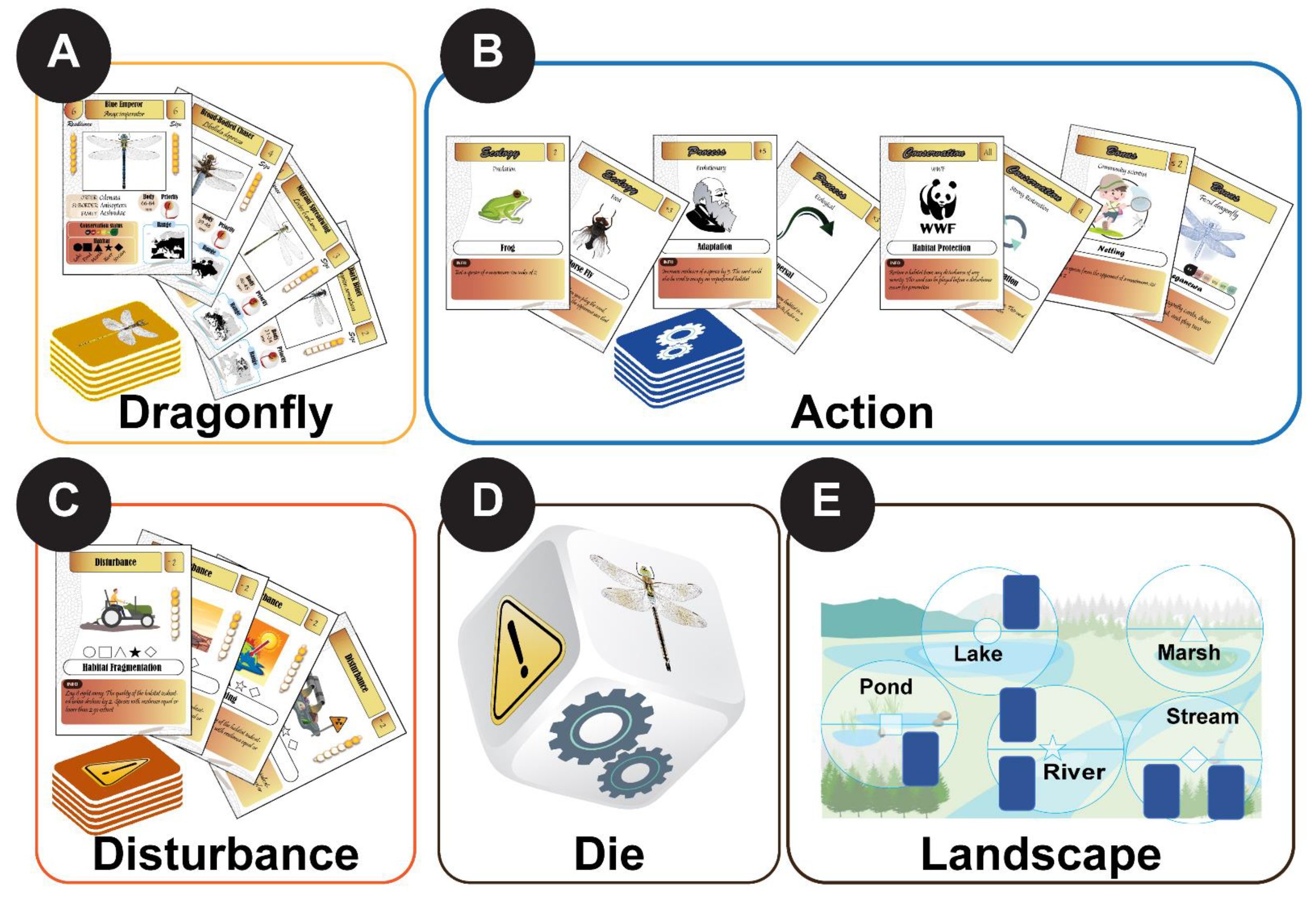
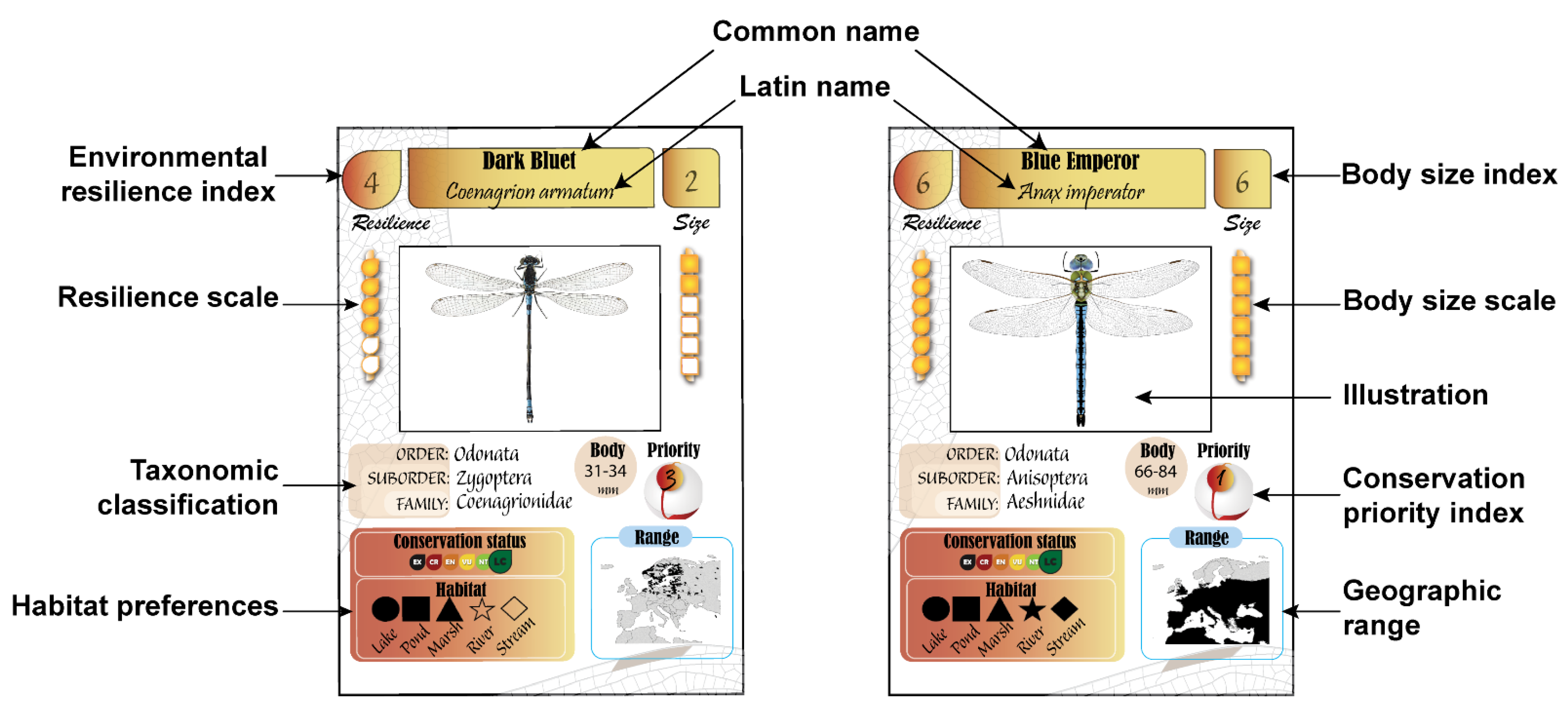

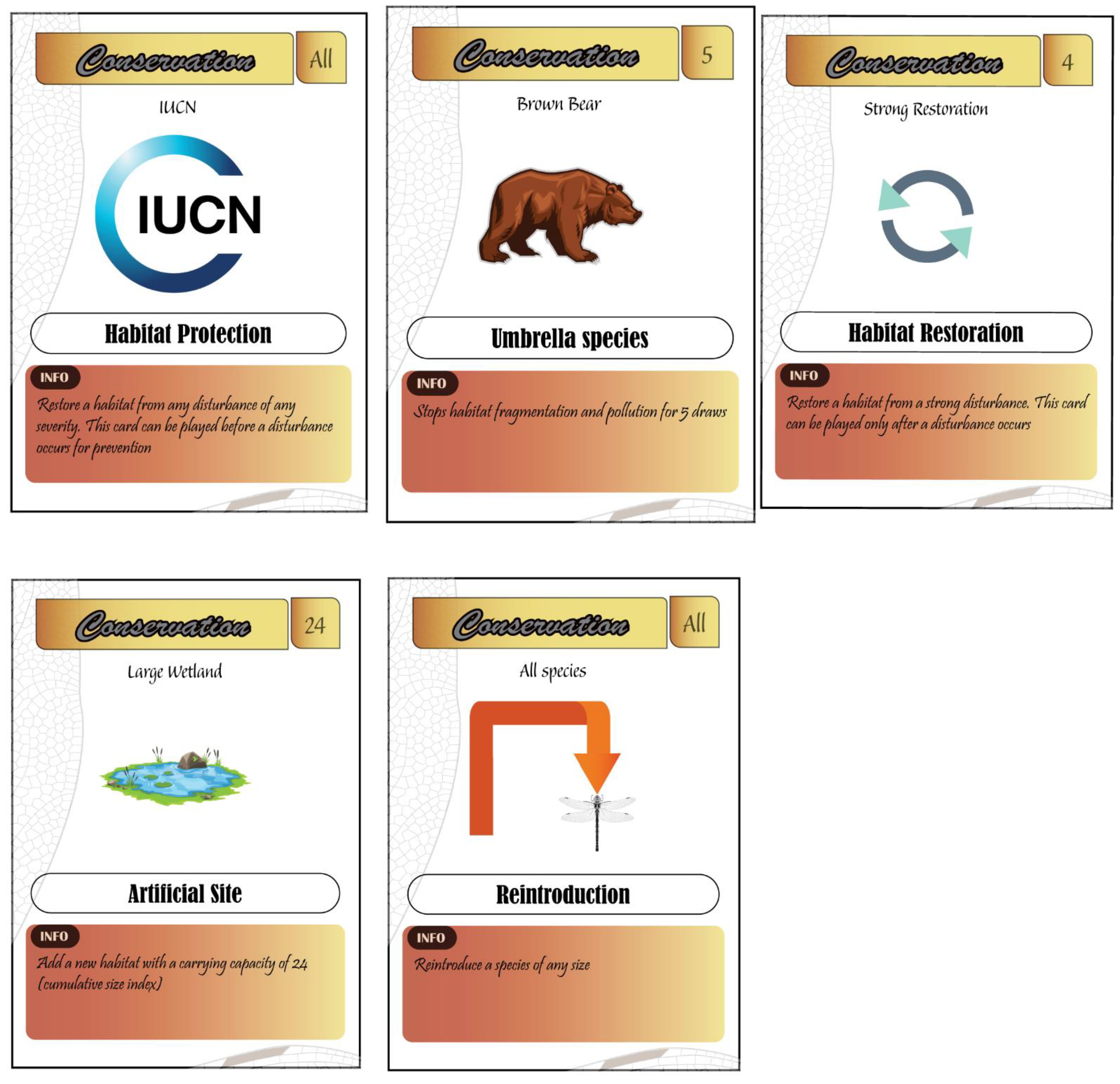

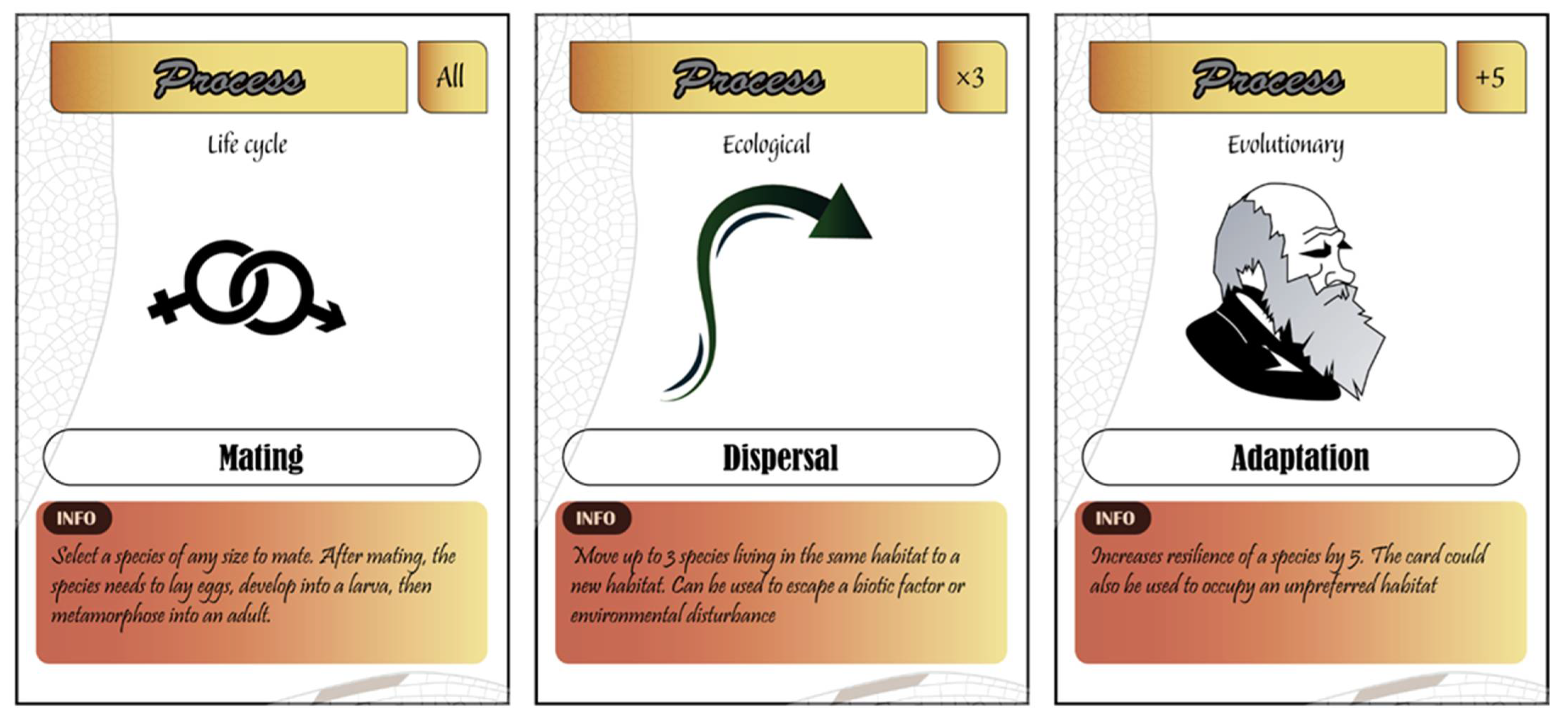
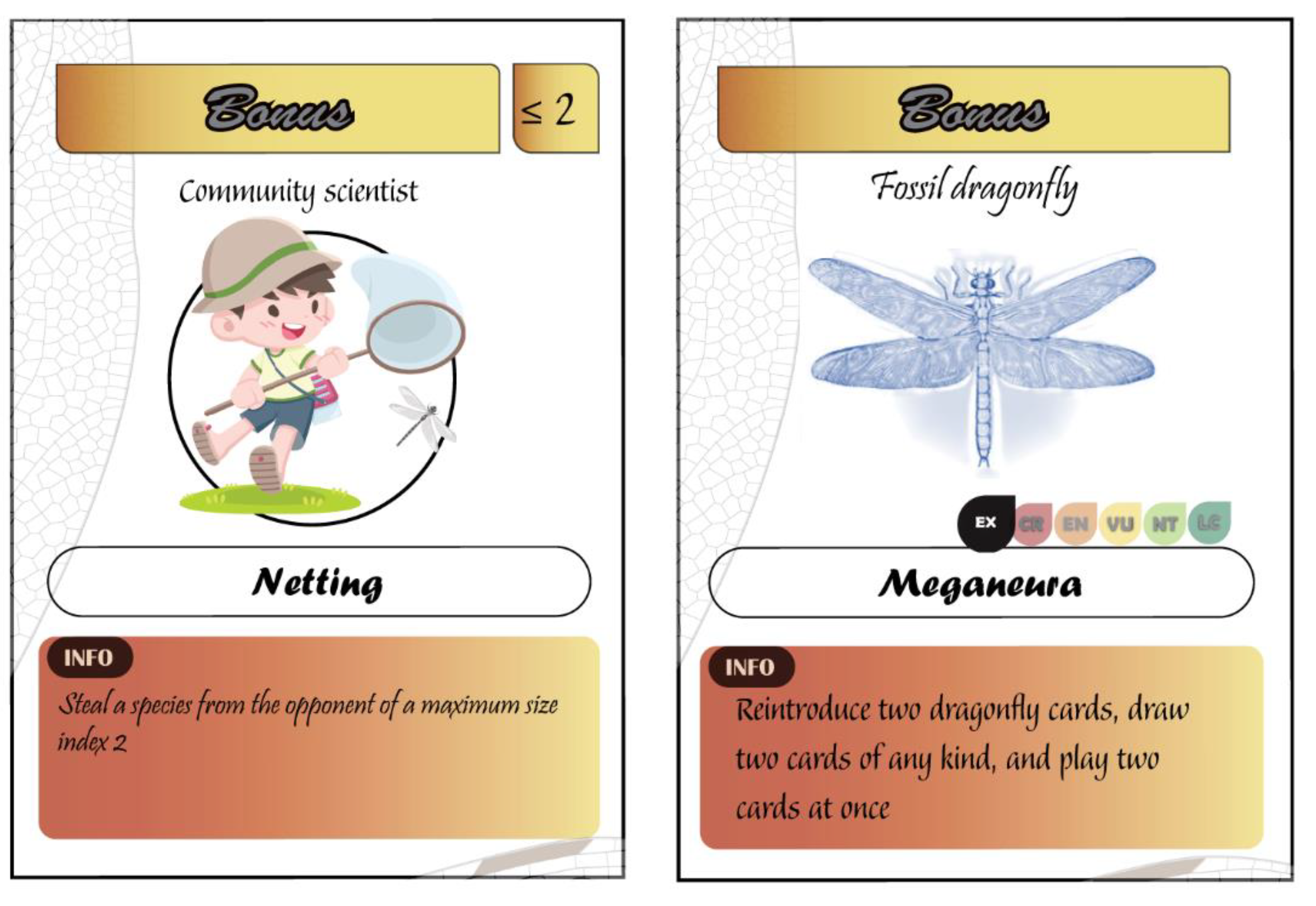
| Card Category | Number of Components | Replicates (Card Levels) | Total Number of Cards |
|---|---|---|---|
| Species | 50 | 1 | 50 |
| Disturbance | 6 | 3 | 18 |
| Action (Ecology) | 7 | 3 | 21 |
| Action (Conservation) | 7 | 3 | 21 |
| Action (Process) | 6 | 3 | 18 |
| Action (Bonus) | 2 | 2 & 3 | 5 |
| Total | 78 | 133 |
| Element | Type | Contents | Pedagogical Relevances |
|---|---|---|---|
| Environment | Aquatic | Habitats Carrying capacity | Diversity of habitats in nature Limits to the capacity of habitats to welcome species |
| Cards | Species | Taxonomic classification: Suborder, family, common and Latin species Ecology: Environmental resilience, habitat preferences, geographic distribution Biology: Body size and behavior | General taxonomy Dragonfly identification Interspecific variability in body size, ecology, and conservation threat |
| Action (Ecology) | Abiotic factors: heat, cold, and wind Biotic factors: predation, intraguild predation, competition, parasitism, and mutualism | Dragonfly activity is highly dependent on the weather. Dragonflies are not active in bad weather Basic essential knowledge in the various types of ecological factors. Ecological barriers to species persistence Importance of species interactions in structuring communities | |
| Action (Conservation) | Conservation organizations: WWF, IUCN, Nature Conservancy, Ramsar Conservation measures: habitat restoration, species reintroduction, umbrella species; artificial sites | Non-profit international organizations for biodiversity conservation Understanding the different methods used to cope with biodiversity loss The importance of the conservation of larger species for smaller species The realization that most environmental problems are anthropogenic | |
| Action (Processes) | Ecological process: Dispersal Evolutionary process: Adaptation Biological process: Life cycle (copulation, eggs, larva, metamorphosis, and adult) | Essential knowledge of ecological, evolutionary, and biological strategies that species use to cope with environmental change Environment, evolution and demography are species’ toolkits to persist in a changing world Dispersal connects communities and shapes habitat biodiversity | |
| Action (Bonus) | Traping: Community scientists, students, and odonatologist Fossil dragonfly: Meganeura and Cephalozygoptera | Disseminating the role of community science in data collection and engagement for research Some of the ancient dragonflies were huge New taxonomic discoveries showed an extinct group (suborder) of dragonflies Awareness of the extinction process which could be exacerbated with human activity | |
| Anthropogenic disturbance | Climate change (drought and warming) Habitat degradation (habitat fragmentation and pollution) Invasive species (fish and tree) | Understanding of the negative impacts of anthropogenic factors on species and assemblages. Awareness that while anthropogenic impacts can permanently damage natural habitats, they could also be reversible. | |
| Die | Random process | Stochasticity plays an important role in determining the fate of populations and species. |
Publisher’s Note: MDPI stays neutral with regard to jurisdictional claims in published maps and institutional affiliations. |
© 2021 by the authors. Licensee MDPI, Basel, Switzerland. This article is an open access article distributed under the terms and conditions of the Creative Commons Attribution (CC BY) license (https://creativecommons.org/licenses/by/4.0/).
Share and Cite
Khelifa, R.; Mahdjoub, H. EcoDragons: A Game for Environmental Education and Public Outreach. Insects 2021, 12, 776. https://doi.org/10.3390/insects12090776
Khelifa R, Mahdjoub H. EcoDragons: A Game for Environmental Education and Public Outreach. Insects. 2021; 12(9):776. https://doi.org/10.3390/insects12090776
Chicago/Turabian StyleKhelifa, Rassim, and Hayat Mahdjoub. 2021. "EcoDragons: A Game for Environmental Education and Public Outreach" Insects 12, no. 9: 776. https://doi.org/10.3390/insects12090776
APA StyleKhelifa, R., & Mahdjoub, H. (2021). EcoDragons: A Game for Environmental Education and Public Outreach. Insects, 12(9), 776. https://doi.org/10.3390/insects12090776






